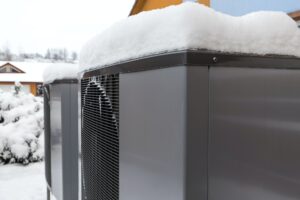Heat pumps and furnaces
When people think of heat pumps and furnaces, they usually think of needing to have one or the other. However, most homes and businesses in the Pacific Northwest greatly benefit from having both. Between energy efficiency and reliability, you’ll want to learn why pairing these two actually serves you best.

If the outdoor temperature is above 40-50 degrees, a heat pump can pull heat from the outside air for less than the cost of running a furnace. However, for extremely cold temperatures such as cold snaps below freezing, you need to rely on a secondary source of heat for your home. Although heat pumps have an emergency heat setting for these freezing temperatures, the cost of running emergency heat is considerably higher and the unit can freeze, leaving you without heat.
Regular heat pumps don’t generate heat from a fuel source, but they use electricity and refrigerant to transfer heat from outdoor air to the indoor space. Heat pumps can transfer approximately 3-4 times more energy than it uses to make it, causing it to be a strongly preferred option for heating your home cost-effectively and lowering your electric bill.
Dual-fuel heat pumps and furnaces
Using a dual-fuel heat pump can be beneficial. This kind of system has an electric heat pump and an alternate fuel furnace. The furnace can burn oil, natural gas or propane to generate heat and send the resulting heat into the home. In the warmer months, the heat pump runs air conditioning. In the spring and fall, the heat pump can heat your home but when there is a significant drop in winter temperatures, the furnace takes over in heating the home to maintain efficiency and lower the overall cost of heating.
Installation costs and energy reduction
The downside to the dual-fuel system is the significant up-front costs, which typically run from $5,000-10,000 with the unit and installation. However, the energy savings can usually recover these costs within five years of use.
If you are considering adding a heat pump to maximize energy efficiency during heating or to enjoy the benefits of air conditioning, you may be in for a pleasant surprise when you notice the drop in your electricity bill. While heat pumps can be installed in any home, there are times when they won’t be the best option. In older homes where there may not be enough insulation, a heat pump has to run longer to heat the house. A poorly insulated home may need a higher temperature to heat the home than the heat pump can provide. In these cases, having a furnace that can heat faster and hotter may be more functional.
Ductless mini-split heat pumps
This is the most energy-efficient and cost-efficient method of heating and cooling, especially when there is not current ductwork in place, or where ducts would be difficult to install. The size of the ductless heat pump needed will vary, dependent on the number of rooms or zones needing to be cooled or heated.
In summary, some homes have a furnace or a heat pump. However, for climates that go below freezing regularly, pairing a heat pump with a furnace can save you money because the energy efficiency and in return cost-efficient is much greater than a furnace. Using the furnace will still be necessary during below-freezing temperatures but the majority of the year, the heat pump’s job is to save you money!
Service, Maintenance and Installation
While heat pumps and furnaces usually last 10-20 years, they must be properly maintained and serviced to keep them in proper working order. Schedule an inspection or service appointment.
If you are considering adding a heat pump to bring down energy costs, special financing offers can be found at Financing | Marysville, WA | Pilchuck Heating (pilchuckheatingwa.com)
Get a Quote Today
More Advice for Homeowners
- How Can I Make My Home More Efficient?
- Is a Home Energy Audit Worth it?
- Difference Between an Air Conditioner and a Heat Pump
- What Does Energy Star Mean?
- What Does HVAC Mean?
- How to Heat Your House for Less
- What is the Most Effective Thermostat Setting?
- How to Protect Your Heat Pump During a Storm
- What You Should Know About CO


